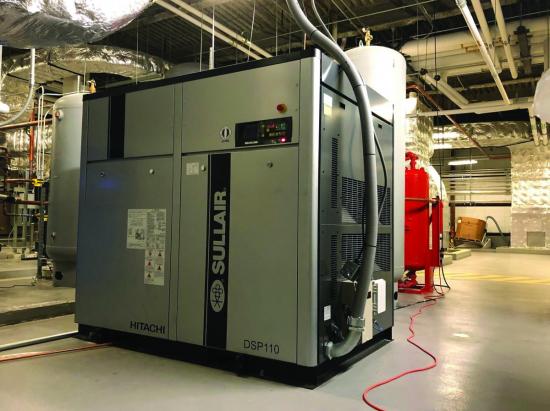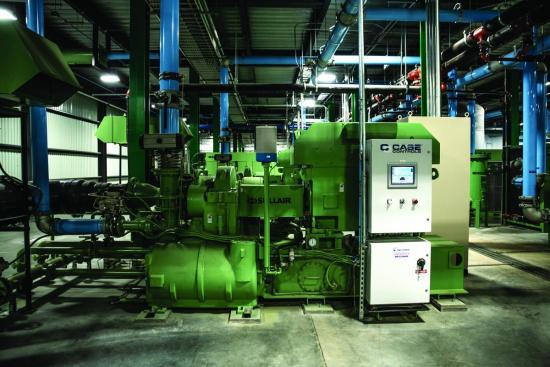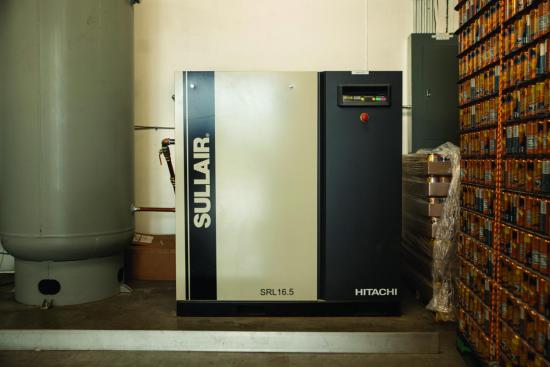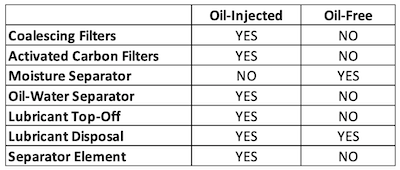The purity of the compressed air that contacts finished goods and their packaging is scrutinized more than ever before. As a result, oil-free air compressors comprise a larger segment of the compressed air market than ever before. In fact, Grand View Research, Inc. projects a CAGR of 4.8% for the oil-free market as compared to a CAGR of 3.8% for the market as a whole (2019-2025).
Despite the growing desire for improved compressed air purity and its association with oil-free air compressors, many end-users are reluctant to transition from oil-injected to oil-free air compression technology because oil-free compression technology is perceived to be less economical to own and operate than oil-injected technology.

A Sullair DSP Series oil free rotary screw air compressor at a pharmaceutical facility.
Oil-Injected vs Oil-Free Debate
There is much more to the oil-injected vs. oil-free discussion than the perceived economics of the compressor itself. The purchase price of the compressor is often a small part of the total cost of ownership.
The total life-cycle cost of the two systems should be considered, along with the environmental impact of the discarded lubricant, contaminated separator and in-line filter elements, as well as the inconveniences associated with the disposal of contaminated condensate.
When the total cost of ownership is considered, including maintenance and power, the difference between the cost of operating an oil-injected and an oil-free system can be less than many users perceive.
The purpose of this article is to raise awareness of the implications of selecting an oil-injected compressed air system in lieu of an oil-free compressed air system.
Comparing Oil-Injected vs Oil-Free Compressed Air Systems
Consider two compressed air systems; one employing oil-injected compression technology, the other employing oil-free compression technology. Both systems are configured to provide similar capacity and ISO 8573-1 Class 0:2:1 compressed air purity.

Enlarge.

Figure 1 – Oil-Injected and Oil-Free compressed air system components. Enlarge.
The system comprising oil-injected compression technology requires more air treatment components than the comparable oil-free system. The oil-injected system requires coalescing filters as well as an activated carbon filter to achieve the same air purity as the oil-free system.
A moisture separator is included in the oil-free system to remove any condensate that results from cooling in the compressed air piping downstream of the aftercooler.
Lubricant Management in Oil-Injected Air Compressors
The typical industrial rotary screw air compressor lasts 15 years or more if properly maintained. Over that life span, the volume of lubricant consumed, both in terms of regular fluid changes and top-off fluid, is significant.
Modern compressed air lubricants are capable of lasting 8,000 hours or more under normal operating conditions. However, the life span of a lubricant may be severely curtailed if the lubricant is subjected to contamination or elevated operating temperatures.
Outside contaminants collect and become concentrated in the compressor lubricant, potentially rendering it harmful to the internal compressor components. Many preventative maintenance programs and manufacturer warranties require regular fluid sampling and analysis.
If the fluid sample indicates contamination or low pH (acidic lubricant), a lubricant flush and change is in order, often well before the anticipated lubricant change date. Each lubricant change requires replacing the separator element, in-line lubricant filter, control line filters and disposing of the spent lubricant.
The need for top-off fluid in the oil-injected compressor results from lubricant carry-over. Lubricant carry-over impacts operation in two ways; the fluid must be replaced to maintain proper lubricant level in the sump and the lubricant that is carried over must be removed by coalescing and carbon filters downstream.
Lubricant carryover can be as much as 3-4 ppm, or more. Compressor short-cycling and draw-down operation can increase carryover significantly.

Table 1 – Comparison of lubricant usage in oil-injected and oil-free rotary screw air compressors. Enlarge.
Technically Oil-Free Air
It is possible, based on the rated filtration effectiveness provided by some manufacturers, to supply technically oil-free air using oil-injected compressors. By using multiple coalescing filters and an activated carbon filter in the oil-injected compressed air system, the air purity rating can exceed ISO 8573-1 Class 1 requirements for oil content.
The filter ratings are provided by reputable testing labs in accordance with applicable standards, and the filters can be expected to provide the needed level of filtration under normal operating conditions.
It is the abnormal conditions that should give pause. What happens if the coalescing or activated carbon filters are unable to remove the lubricant from the air stream?
If carryover becomes excessive, it is entirely possible that the filtration system becomes overwhelmed, and the delivered air does not meet the anticipated standard. Something as simple as a failed drain on a coalescing filter could create such a scenario.
Once lubricant is present in the system, it is very difficult to remove. One upset condition could contaminate large quantities of raw or finished product and result in significant clean-up efforts and costs and process downtime.

A Sullair centrifugal air compressor at a glass manufacturer in Georgia.
Power Consumption
Oil-injected compressors often enjoy the benefit of being more efficient than their oil-free counterparts, if Specific Energy (kW/100 CFM) is considered at face value.
If the oil-injected and oil-free compressed air systems are intended to deliver the same pressure to the plant, the oil-injected compressed air system must overcome additional pressure loss associated with the coalescing and activated carbon filters required to provide comparable air purity to the oil-free system.
If the pressure loss across the additional in-line filters is estimated as 2.8 psid, the oil-injected compressor discharge pressure must be set to 2.8 psi higher than the oil-free compressor, thus increasing the power consumption of the oil-free compressor by approximately 1.4%.

Table 2 – Comparison of required air compressor delivery pressure.
Regular monitoring of the sump lubricant level and the addition of the correct lubricant are common maintenance tasks required by an oil-injected air compressor. Properly adding lubricant to an oil-injected compressor is sometimes more complex than it appears.
Most facilities have many industrial fluids on hand; gear oils, coolants, cutting fluid, and lubricants. It is easy for the well-intentioned maintenance technician to add the wrong fluid to the compressor sump. Incompatible fluids often foam, leading to excessive carryover and the need to completely flush the compressor and replace the downstream air treatment components, sometimes including the media in a regenerative dryer.
In summary, managing the lubricant in an oil-injected compressed air system is no simple task. The total volume of lubricant used by an oil-injected compressor over its life span is significant and should be part of the discussion when considering oil-free vs oil-injected compression technology.
Oil-Injected Compressed Air System Condensate Management
Oil-injected compressed air systems generate contaminated condensate that is either collected in an oil-water separator before being released to a waste water stream or is discharged directly to a waste water stream. In either case, the end-user must obtain a permit for the effluent associated with the compressed air system.
If an oil/water separator is used, the filtration elements must be monitored and changed on a regular basis. Proper selection of an oil/water separate requires in-depth knowledge of the application, including the type of lubricant, climatic conditions, and compressor capacity.
The oil-contaminated condensate causes the end-user to incur maintenance costs and/or administrative burdens that are not present with an oil-free compressed air system.
Please note that proper permits must be obtained prior to discharging any effluent to a municipal sewer system.
Condensate Generation: At 84 °F, 61% RH, a 500 ACFM oil-injected compressor generates 4 gallons/hour of lubricant-contaminated condensate that must be properly treated.

A Sullair SRL Series oil free scroll air compressor at a brewery in Seattle.
Risk Management
Manufacturing personnel considering oil-free compression technology may be evaluating the decision from the perspective of risk. What is the risk of using oil-injected compression technology in my plant?
For a manufacturer of food, pharmaceutical, beverage, or electronic products, the risks may be substantial. From potentially contaminating raw materials to finished goods, an excursion in the oil-removal system of an oil-injected compressor system poses significant financial risk.
The risk goes beyond the immediate financial risk to the manufacturer. Potential product recalls and damage to the reputation of the manufacturer are also risks presented when applying oil-injected compression technology in sensitive applications.
Conclusion
Oil-injected air compressors represent the lion’s share of the industrial compressed air market today. And for good reason, as oil-injected rotary screw air compressors are a proven, reliable, efficient and cost-effective means to generate compressed air.
The risks to many industrial processes of lubricant carry-over and contamination are minimal, or easily addressed with point-of-use air treatment. For those applications, oil-injected compression will likely continue to be the chosen technology for many years to come.
When choosing oil-injected compression technology for a compressed air system, consideration should be given to the entirety of maintenance tasks that will be required.

Table 3 – Comparison of maintenance tasks.
When air purity is essential to product safety or quality, oil-free compression technology should be given serious consideration.
Perhaps the question to ask is not “Is the oil-free system more expensive,” but rather “Is the money saved using the oil-injected technology worth the risks and environmental impact?”
About the Author
Brian Mann ME, PE is the Air Systems Manager for Sullair. Since joining Sullair in 2019, Brian has collaborated with Sullair channel partners and end-users to maximize compressed air system energy efficiency. He holds a master of engineering in mechanical engineering degree from the University of Louisville. Brian may be reached at brian.mann@sullair.com.
About Sullair
Sullair, founded in Michigan City, Indiana, in 1965, is a leading global provider of compressed air solutions. The company was one of the first to execute rotary screw technology in air compressors, and its machines are known throughout the world for their reliability, durability and performance. Sullair became a Hitachi Group Company in July 2017. For more information, visit www.sullair.com.
To read similar Air Compressor Technology articles, visit www.airbestpractices.com/technology/air-compressors.
For expert presentations, visit our Webinar Archive Section dedicated to Air Compressor Technology at www.airbestpractices.com/webinars.




